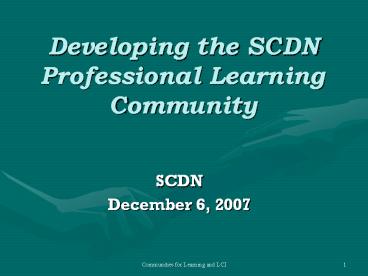Developing the SCDN Professional Learning Community - PowerPoint PPT Presentation
1 / 38
Title:
Developing the SCDN Professional Learning Community
Description:
516-502-4231, and 516-502-4232. www.lciltd.org. www.communitiesforlearning.org. gmklci_at_aol.com. Facilitated by. Communities for Learning and LCI. 3. Outcomes ... – PowerPoint PPT presentation
Number of Views:22
Avg rating:3.0/5.0
Title: Developing the SCDN Professional Learning Community
1
Developing the SCDN Professional Learning
Community
- SCDN
- December 6, 2007
2
Facilitated by
- Giselle Martin-Kniep
- Communities for Learning
- Leading Lasting ChangeTM
- Learner-Centered Initiatives, Ltd (LCI)
- 516-502-4231, and 516-502-4232
- www.lciltd.org
- www.communitiesforlearning.org
- gmklci_at_aol.com
3
Outcomes
- Explore the relationship between leadership style
and professional learning communities - Develop a vision for the SCDN professional
learning community using leadership style as an
entry point - Assess the SCDN organizational readiness to
support professional learning communities - Identify interventions to promote the capacity of
SCDN to support professional learning communities
4
Exploring our leadership style(based on
Hargreaves, 2007)
- Who are you most of the time in your place of
work?
5
Autocratic
- You will.
- Delegating what we hate to do
- Promotes resistance
6
Traditional delegation
- Maximizes existing structure
- Maintains or improves the existing management of
an institution - Convenient
7
Progressive delegation
- Changing structures to create different kinds of
conversations - Feels like change (i.e., multi-age teams
co-teaching job sharing)
8
Guided distribution
- Necessary if there is no collaborative structure
in the organization - No no go area
9
Emergent distribution
- Creates a culture where leadership comes forward
- Genuinely shared vision
10
Assertive distribution
- Shared vision and arguments over best way to
achieve it - Hard to follow this style
11
Anarchy
- Anything goes
12
Skillful leadership is flexible and
differentiated (balancing purpose, style and
needs)Andy Hargreaves Chris James
13
Grouping activity
14
Visioning activityParts 1 and 2
15
So. what is a Communities for Learning
professional learning community?
16
Communities for Learning Definition
Collective forums that share a purpose, a vision
and goals related to developing schools as
learning organizations
17
Participants may include
- Teachers
- Students
- Parents
- Principals and other building administrators
- District administrators
- Professional developers
- Board members
- Community members
- School counselors
- University faculty
- School specialists
18
Why multiple roles?
- Access to multiple perspectives
- De-politicized discourse
- Better access to the complex nature of teaching,
learning and school systems
19
What differentiates one professional learning
community from another?
20
Communities that Learn
- Include individuals whose primary focus is
learning to increase understanding about an issue
or topic or area of interest related to teaching
and learning.
21
Communities that Lead
- Comprise participants who are committed to
leading the learning of others. They remain
learners, but their learning is focused on
deepening their own leadership and facilitation
skills.
22
Communities that Last
- Focus on sustaining the learning and work of the
community and organization. Their learning
revolves around systems dynamics, strategic
planning and organizational development.
23
Visioning Activity
- Parts 3 and 4
24
How might leadership style relate to professional
learning communities?
25
Core Elements of Communities that learn, lead
and last
26
Identification, Cultivation and Use of
Expertise/Experience
27
Alignment of Individual and Organizational
Passions, Needs and Vision
28
Development of Dispositions of Practice
- Commitment to Understanding
- Intellectual Perseverance
- Courage and Initiative
- Commitment to Reflection
- Commitment to Expertise
- Collegiality
29
Activity with Dispositions
30
Commitment to Understanding
- Looks like
- pursuing questions and developing ideas related
to teaching and learning - using research and evidence
- accessing multiple perspectives
31
Intellectual Perseverance
- Looks like
- considering ideas or questions for a period of
time to improve our work - revising and revisiting our work and our thinking
to improve it and to reach high standards - withholding the need to finish work before its
the best that it can be
32
Courage and Initiative
- Is
- discussing uncomfortable topics or issues,
including own values and questions - accepting the discomfort that stems from the need
to change - seeking or accepting new or unfamiliar roles,
responsibilities or challenges
33
Commitment to Reflection
- Looks like
- sharing our thinking to develop and evaluate it
- thinking about our thinking and learning to set
goals, assess and understand ourselves, our work
and our organization - producing work that results from goals, actions
and strategies that are grounded in the analysis
of past learning
34
Commitment to Expertise
- Is
- refining and expanding our current professional
knowledge and skills - disseminating our knowledge and expertise within
and outside our own organization - engaging in learning and work that addresses
organizational or professional needs
35
Collegiality
- Is
- learning with and from others
- acting on the belief that learning and working
with others increases our expertise - producing work that results from engaging in
collaborative learning and problem solving
36
Defining the distance between our vision and our
current reality
37
Assessing SCDNs Organizational Readiness
38
Identification of Interventions to Increase
Organizational Readiness































